Are Polarized Sunglasses Good for Driving At Night? (Facts & FAQ)
Last Updated on
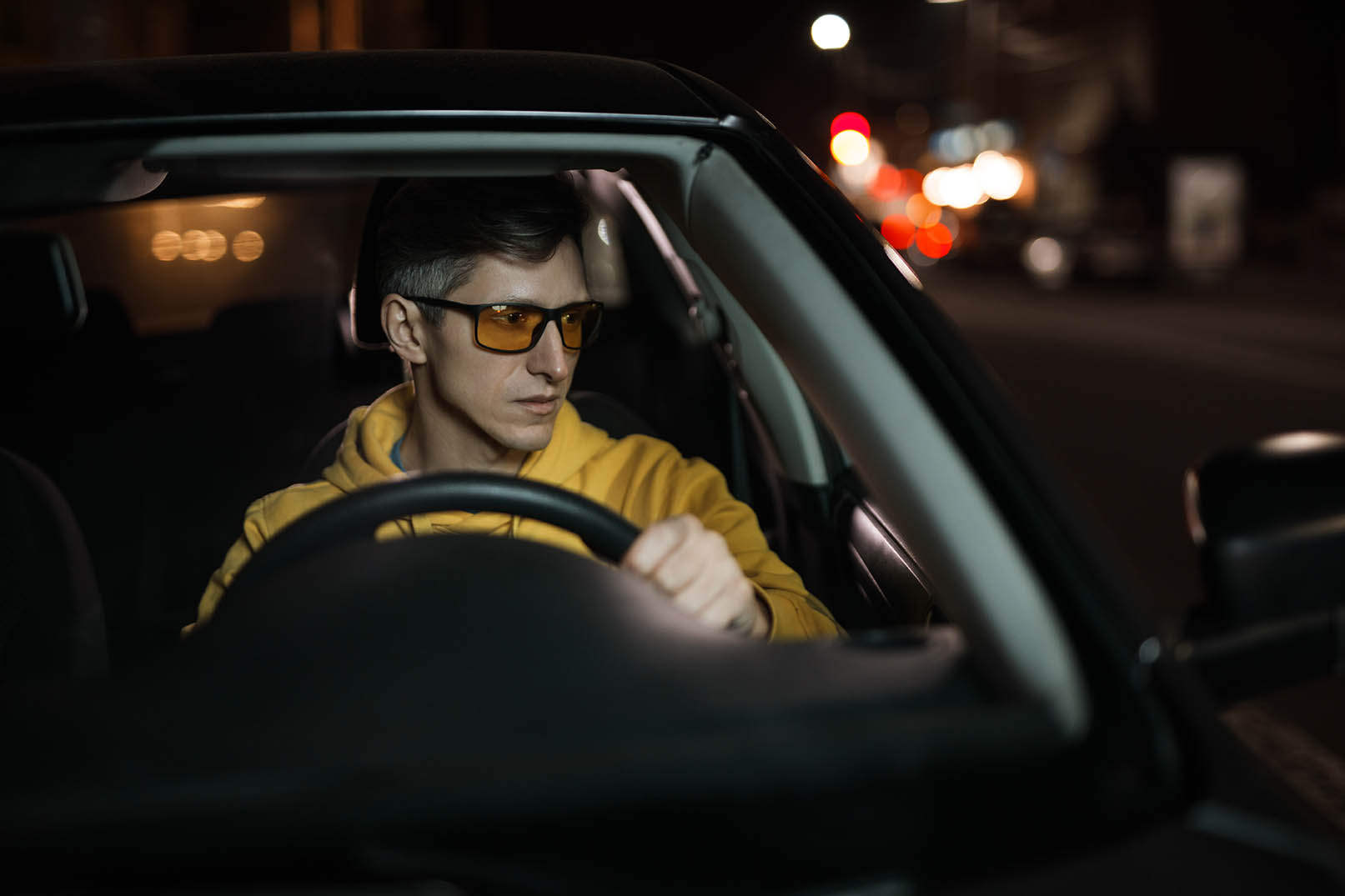
As kids, we used to think guys who wore sunglasses while driving at night only wanted to look cool. Little did we know, there are people out here who have great vision during the day, but struggle at night.
And now that we’re older, we feel like it’s time to learn more about these sunglasses, and what makes them so special.

How Do Polarized Sunglasses Work?
Polarized Lenses
A polarizing chemical is applied to the lenses of the eyeglass and laminated in a vertical pattern so as to help it reorganize the light that tries to pass through. The ultimate goal of doing all this is to make the lens function in the same way as a window blind—blocking horizontal light and hence, eliminating glare.
Of course, we’ll go heavy on the details while discussing glare and how it affects the human eye, but because this section needs a little more context, you have to know this:
When light waves keep on bouncing off of any reflective surface, be it a shiny car bumper or even a lake, you’ll for sure experience glare. That’s because all horizontal surfaces that are capable of reflecting any amount of light will only do so horizontally, and not vertically.
Because the chemical laminate pattern on your eyewear’s lenses is vertical, filtering out horizontal light is a cakewalk. Consequently, blocking glare.
Polarized lenses normally create images that are a tad bit different from those created by a typical lens. A quick comparison between the two is all you need to realize they often appear darker, but much more detailed. Ipso facto, reduces eye strain.
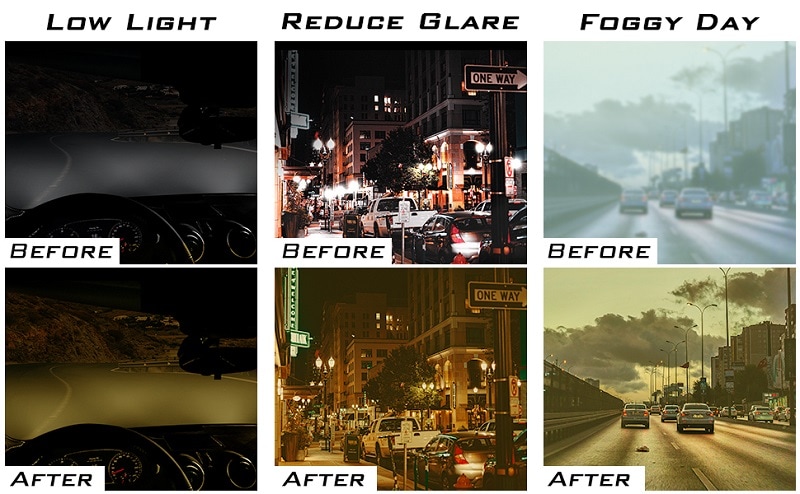
Type of Polarized Lenses
The type of lenses used in nighttime driving sunglasses are normally polarized in different ways and degrees. And as such, you’ll find that there’s always a disparity in pricing. Cheaper lenses have an attenuated/thin chemical laminate on one side of the lens. Therefore, you shouldn’t expect it to be as efficient as the thicker, two-sided laminate.
Investing in polarized sunglasses designed with a thin layer might not be such a good idea because scratching or rubbing off that layer is pretty easy. Moreover, compared to the expensive lenses, they don’t offer much in terms of benefits.
The construction aberrations/defects are the other things that you’ll hate about these types of lenses. Because they’re usually mass-produced, they always seem… different. It’s almost as if the manufacturer is telling you that they could have done better with the quality, but they aren’t being paid enough.
The best-polarized lenses in the market have been laminated on both sides. Therefore, it’s almost impossible to inadvertently scratch it or even compromise the structure in any way. Also, because they all have a thicker polarizing film, they tend to be more protective against glare.
Side Note: The color of a lens has nothing to do with how well it protects your eyes when you’re on the road at night. There’s this perceived notion that dark colored lenses are more effective than brightly colored ones and that’s not true. If you’re not sure what type of lens suits you, reach out to an optometrist. They’ll help you choose the ideal eyewear based on the lens’ design, material, and color preference.
Why Use Polarized Sunglasses While Driving?
Not many people like driving at night because they fear straining their eyes. Eyestrain is basically a medical condition experienced when the human eye muscles feel overworked. This condition can be annoying, and contrary to popular belief, it’s not just caused by underlying diseases.
They say an ounce of prevention is far much better than a pound of cure. So if you don’t want to spend the better part of your life having your eyes checked, use them any time you feel a strain while driving at night. They’ll not only reduce blinding glare, but also ameliorate acuity and visual comfort.

Why Wouldn’t We Use Polarized Sunglasses?
We honestly appreciate the fact that polarized lenses have made driving at night easier for some people, but we can’t fail to talk about the downside. You see the thing is, they don’t just reduce light from oncoming traffic. You also might not be able to read any digital sign because you’ll be seeing Liquid Crystal Displays—a distortion caused by polarized lenses.
We would recommend the normal prescribed glasses instead of polarized sunglasses for anybody grappling with vision problems.
Tinted Lenses
A tinted lens is meant to minimize fatigue, and increase comfort for drivers driving during the daytime. However, for those driving under the cover of darkness, it serves a different purpose. Depending on the lens’ tint absorption value, it will have a dimming effect that makes it easier for the guy behind the wheel to see oncoming traffic.
But there’s a drawback to this. It doesn’t just dim headlights of oncoming traffic. It also dims illuminated road signs, traffic signals, and taillights. Some drivers have even noted that it reduced their visual acuity, and almost got them involved in an accident.
We know that there are people out there that can’t drive without their prescription lenses, so we’re going to offer an alternative. If you want to increase your margin of safety on the road, use anti-reflective lenses that have no tint. From an anecdotal point of view, sunglasses that are designed to offer a lower light transmission rate are more appropriate for night driving.
Lens Material
The type of material used in construction will depend on how well it decreases glare or amplifies light. Manufacturers already know if the glasses are to be used by nighttime drivers, they can’t go with the same materials used on ordinary sunglasses. They’ll either have to use Trivex or Polycarbonate.
Sunglasses made of polycarbonate are the most preferred type mainly because they’re affordable and of great quality. In addition, they’re not as heavy as your typical eyewear, and are very durable. Unfortunately, even though they’re shatterproof, we can’t be blinded to the fact that they also have the same construction aberrations as plastic lenses—A reduction in optical quality.
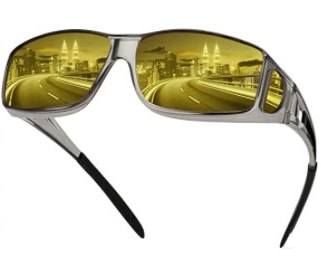
Sometimes referred to as the SR91, the Trivex has been hailed as the best lens material in the market. You just don’t hear much about it because it’s too costly in comparison to the Polycarbonate material. Trivex doesn’t scratch easily, is completely unfazed when exposed to external shock, and weighs less. It practically has everything that you’d ask for in a material.
What’s Glare?
Without light, accomplishing any task would be virtually impossible. Think about driving, for instance. Nobody would even think about getting behind those wheels knowing very well that they wouldn’t be able to see anything.
But then again, too much light is not ‘good light’, if you know what we mean. It will definitely blind you, and that phenomenon is what’s referred to as Glare.
Blinding Glare
Also known as the dazzle glare, this is the overabundance of utilitarian light. The lenses of your sunglasses have been designed in such a way that they only allow sufficient light to pass through them. By sufficient we mean about 20 percent of the light you’re exposed to. Anything above that is deemed excessive, and damaging to the human eye.
Night drivers—especially those who fall under the senior citizen category—have often complained about blinding glare caused by oncoming traffic. In fact, there’s a school of thought that explains in detail why that’s the case. Apparently, once you hit a certain age, your glare recovery time significantly increases. So, if it only took 10 seconds for your eyes to readjust after exposure, once you hit that age you’ll take longer to see again properly.
Veiling Glare
It’s not as bad as the blinding glare but just as bad. Occurrence of the veiling glare will depend on light intensity, and how often you clean the inside of your car’s windshield is. You’re advised to clean your windshield from time to time because even though you won’t see it, a film will always be formed over time. This film is invincible during the day and under low intensity light, but becomes very visible at night when the headlight of oncoming traffic illuminates it. At that point, we’ll say your view has been veiled.
Quite frankly, you don’t need polarized sunglasses to deal with this issue. As long as your windshield is clean, all will be well.

The light reflected by the dashboard can also cause veiling glare. And if statistics are anything to go by, road safety experts have concluded that some of the worst road accidents in the United States have been attributed to light reflected in this fashion.
Ghost Image Glare
This has nothing to do with superstition. The ghost images that night drivers end up seeing are images created by light that has been reflected within the sunglass’s lenses. They’ll definitely be a hindrance to night driving because they’re fatiguing, and can be distracting.
To resolve the issue of the ghost image glare, you can opt for an anti-reflective lens. They’ll not only deal with that problem, but also extend your headlight reach.
Related Read: When Should Safety Glasses Be Worn?

Frequently Asked Questions
Does the design of the night driving sunglasses account for much?
Yes, it does. The design is just as important as the lenses of your night driving sunglasses. Some glasses have arms that are too wide, while others have arms that are too narrow. Assuming you’re wearing one that has a wider arm, you’ll realize your field of vision is sort of narrower than usual.
Anything that limits a driver’s peripheral vision should be kept at bay because seeing what else is happening out of the corner of your eyes won’t be possible. We would recommend night driving glasses designed with thin temples, should you feel the need to drive while wearing one.
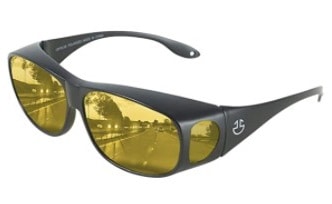
Is night myopia a thing?
Yes, it is. Myopia is a scientific word used to describe nearsightedness. A condition whereby a person can clearly see all the details of the object close to them, but finds it hard to see anything at a distance.
Naturally, the human eye is supposed to focus images on the retina after refracting light. But in the case of night myopia, the light rays that enter the eye tend to refract incorrectly, thereby focusing images at the front of the retina.
Night myopia can affect anyone, including people who have normal vision. That’s why you’ll hear someone talk about how they can clearly see objects farther away during the day, but for some reason, struggle at night.
What’s the one mistake that most people make when buying night driving sunglasses?
Investing in cheap eyewear. Our advice is this: don’t buy them if you’re working with a tight budget, or if you just want to look cool in front of your friends. In this industry, cheap is the other name for low-quality products. And low-quality night driving sunglasses can permanently damage your retina.
What’s the best way to improve a driver’s night vision?
First off, dim your dashboard. Those bright lights could distract you from the road, and ultimately, cause an accident. And if you have to use the GPS, switch on its night mode. Secondly, ensure all your mirrors and windows are clean. You may not be able to notice dirt on your windshield during the day, but you definitely will once the sun sets.
Finally, yet importantly, if your glasses are yellow-tinted, leave them at home. There’s no scientific evidence out there that has proven that this type of eyewear ameliorates nighttime visibility.
Is the progressive lens suitable for nighttime driving?
Glasses designed with progressive lenses have combined various solutions to different visual issues in a single pair. So anyone who’s myopic or hyperopic can wear them. But it’s always good to first consult with your optometrists before using any type of eyewear designed for visual problems.
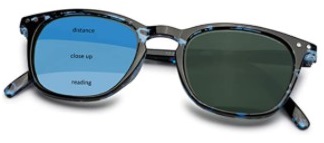
What causes decreased night vision?
It can be caused by anything, but the common cause is macular degeneration. The areas in our eyes that are dedicated to details are gradually destroyed, and as a result, take too long to regenerate. People who have a decreased night vision will take longer navigating any dark room after spending too much time in places filled with lights that are too bright.

In Conclusion
Go ahead and book an appointment with your eye doctor, if you’ve suddenly realized that driving at night is slowly becoming a nightmare. And don’t start freaking out. Having a decreased night vision does not mean that you’re going blind. As matter of fact, thanks to the anti-reflective lens technology, billions of drivers who’ve experienced this same problem before are still driving comfortably at night.
Featured Image Credit: AntGor, Shutterstock
Table of Contents
- How Do Polarized Sunglasses Work?
- Frequently Asked Questions
- Does the design of the night driving sunglasses account for much?
- Is night myopia a thing?
- What’s the one mistake that most people make when buying night driving sunglasses?
- What’s the best way to improve a driver’s night vision?
- Is the progressive lens suitable for nighttime driving?
- What causes decreased night vision?
- In Conclusion
About the Author Robert Sparks
Robert’s obsession with all things optical started early in life, when his optician father would bring home prototypes for Robert to play with. Nowadays, Robert is dedicated to helping others find the right optics for their needs. His hobbies include astronomy, astrophysics, and model building. Originally from Newark, NJ, he resides in Santa Fe, New Mexico, where the nighttime skies are filled with glittering stars.
Related Articles:
Binocular Magnification Chart: Numbers & Distances Compared
How to Clean a Refractor Telescope: Step-by-Step Guide
How to Clean a Telescope Eyepiece: Step-by-Step Guide
How to Clean a Rifle Scope: 8 Expert Tips
Monocular vs Telescope: Differences Explained (With Pictures)
What Is a Monocular Used For? 8 Common Functions
How to Clean a Telescope Mirror: 8 Expert Tips
Brightfield vs Phase Contrast Microscopy: The Differences Explained
